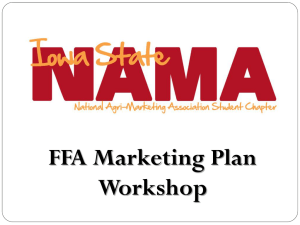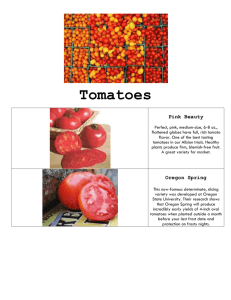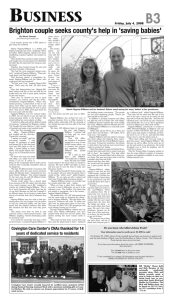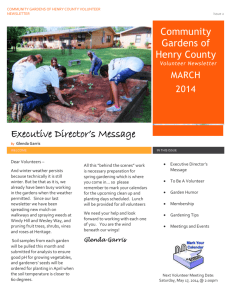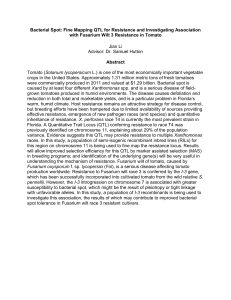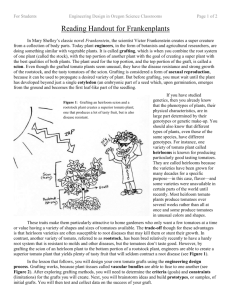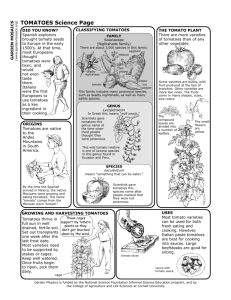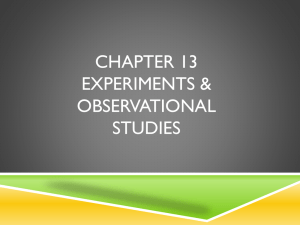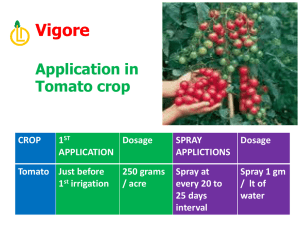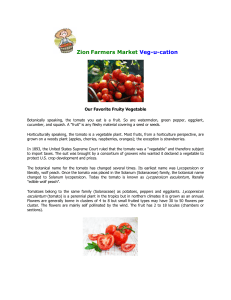Commonsense Vegetable Gardening for the Texas Gulf Coast
advertisement
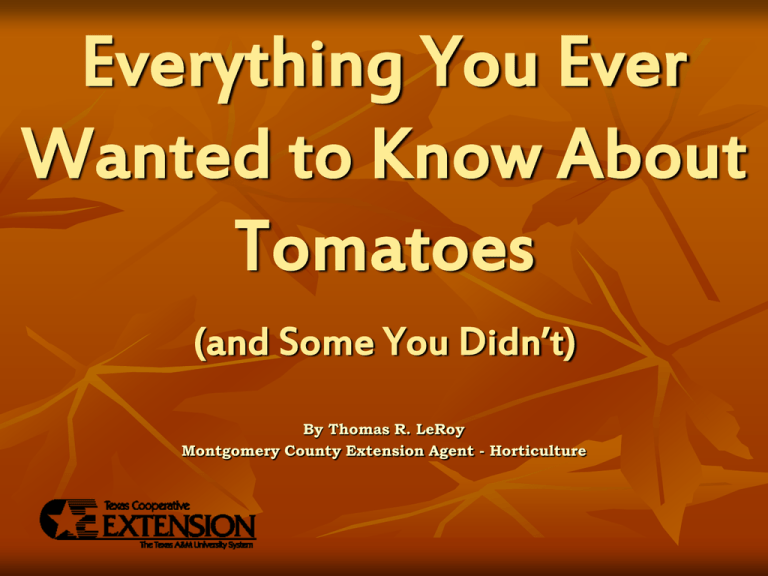
Everything You Ever Wanted to Know About Tomatoes (and Some You Didn’t) By Thomas R. LeRoy Montgomery County Extension Agent - Horticulture Little Known or Cared About Tomato History (Trivia) Where do tomatoes come from? Western coast of South America, present-day Peru. Eight species of tomatoes still grow wild in the Andes Mountains. Cultivated tomatoes have been classified into five botanical varieties. The tomato was an important crop among New World Indians by the 15th century. Aztecs called it “Xitomatl”. Early Aztec writings mentioned dishes comprised of peppers, salt and tomatoes. Could be the original salsa recipe! More Tomato Trivia Central American tribes called it “Tomati” The tomato made its way across the Atlantic shortly after Cortez conquered the Aztecs in 1521. The earliest mention of tomato in European literature was found in Italy in 1544. Tomatoes, described as pomi d’oro (Golden Apple) were eaten with oil, salt and pepper. This means, yellow varieties may have been the first to reach the Old World. Red varieties were introduced to Italy by two Catholic priests many years later (exact date not known). Even More Tomato Trivia Tomatoes became widely cultivated over the next several decades in Spain, Italy and France where it was called pomme d’amour (Love Apple). It might have been used as an early aphrodisiac. German folklore –witches used members of the nightshade family to summons werewolves (a practice known at lycanthropy). The common German name for tomatoes translates to “Wolf Peach”. The scientific name for tomato is Lycopersicon esculentum which means “edible wolf peach”. English writings as early as 1578 referred to the tomato as an ornamental. Can you believe it! More Tomato Trivia Plants were brought BACK to the Americas by colonists early on, as ornamentals from Britain. Northern European cultures associated the tomato with poisonous members of the nightshade family, specifically henbane, mandrake and deadly nightshade which resemble their edible cousin. In 1596, one English author refers to “love apples as being eaten abroad”, but having “a rank and stinking savour.” The first cook book to mention tomatoes was published in Naples, Italy in 1692. In 1752, English cooks used tomatoes sparingly to flavor soups. All right, enough is enough! In 1781 Thomas Jefferson brought tomatoes to his table, along with French fries. He is given credit, by many, for popularizing tomato use in North American culture. New Orleans cuisine is reported to have incorporated tomatoes by 1812. Col. Robert Gibbon Johnson supposedly put all doubts about tomatoes to rest in 1820 when he ate a bushel of tomatoes on the Boston courthouse steps. Thousands are reported to have turned out to watch the poor man die. “HE DIDN’T!” Fruit or Vegetable ? The United States Congress passed the Tariff Act of 1883 requiring a 10% tax on all imported vegetables. A tomato importer decided to challenge the Act on botanical grounds that tomato was technically a fruit not a vegetable and therefore should be exempt. In 1893 the case Nix vs. Hedden, 149 U.S. 304, came before the Supreme Court. The court ruled that although tomatoes were considered the “fruit of the vine” they are generally eaten cooked or raw and served during the “principal part of the repast” and therefore a vegetable “not like fruits generally, as desert.” How to Become a Green Thumb Tomato Grower Select Recommended Varieties. Plant at the Right Time. Proper Soil Preparation and Fertilization. Control Weeds, Diseases and Insects. Adequate Soil Moisture. Harvest at the Right Time . Ideal Garden Location Receives 8 + hours of sunlight. Soil has good internal and external drainage. Free from competition from other large plants, buildings, etc. Near a source of water. Visible! Starting Your Own Tomato Transplants Select Proper Varieties. Sterile Potting Media. Sterile Containers. High Light Intensity for 14-16 hours. Regular Applications of Soluble Fertilizer Temperature and Fruit Set Fruit-set is affected by night temperature. Night temperatures below 50°F delays the time from pollination to fertilization causing flower drop. Night temperatures above mid 70’s disrupts pollen shed causing flower drop on large fruited varieties. When is a Tomato Really Ripe? GREEN - Stage 1 tomato is completely light to dark green. BREAKER - Stage 2 “break” in color from green, to tannish-yellow, pink or red (less than 10%). TURNING - Stage 3 -10% but not more than 30% shows a change in color. PINK - Stage 4 more than 30% but not more than 60% shows pink or red color. LIGHT RED Stage 5 -more than 60%, not more than 90%, shows pinkish or red color. RED - Stage 6 more than 90% of the surface is red in color. Staking versus Caging Growth Habit of Tomatoes Determinate Floriamerica Mountian Delight Bush Celebrity Bush Early Girl Carnival Jackpot Solar Set BHN 444 Heatwave Semi Celebrity Heartland SuperTasty Indeterminate Beefmaster Super Fantastic Champion Dona Early Girl Brandywine First Lady Better Boy Big Beef What’s the Alphabet After the Variety Name? ASC - Alternaria Stem Canker BSp - Bacterial Speck F - Fusarium Wilt F1 - Fusarium Wilt race1 F2 - Fusarium Wilt race2 N - Nematodes V - Verticillium Wilt V1 - Verticillium Wilt, race 1 V2 - Verticillium Wilt, race 2 TMV - Tomato Mosaic Virus St - Stemphylium (gray leaf spot) Intermission Recipe for Successful Tomato Production Champion, highest producer ever in our trials at 73 lbs./plant Average production on modern hybrids is 40-50 lbs./plant. Average home gardener produces less than 10 lbs./plant. 1. Plant large, vigorous plants. Incorporate ¼-½ cup of complete, slow release fertilizer at planting. 2. Wrap tomato cages with row cover. Benefits of Row Cover. 2° to 4° F of Frost Protection. Wind Protection. Keeps Out Insects. Allows 85 to 90% Light Penetration. Up to 30% Increase in Production. 3. Apply a weekly foliar spray of a water soluble fertilizer with micronutrients. 4. Work in 2-3 Tbs. of high nitrogen fertilizer when 1st cluster of fruit sets. Totally Terrific Tomatoes Bush Celebrity (61) Solar Set (53) Dona (53) Carnival (54) Heatwave (50) Early Girl (50) Champion Celebrity Totally Terrific Cherries Juliet (57) Baxter’s Early Bush Sweet Chelsea Yellow Pear Totally Tomatoes 1 (800) 345-5977 www.totallytomato.com Tomato Growers 1 (888) 478-7333 www.tomatogrowers.com Common Diseases and Insects of the Nightshade Family The End

